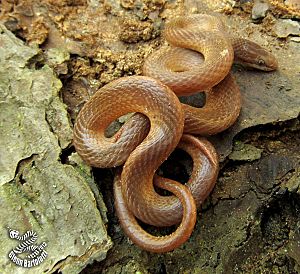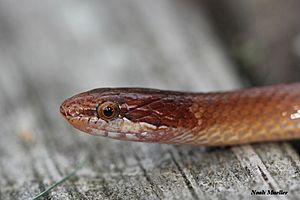Pine woods snake facts for kids
Quick facts for kids Pine woods snake |
|
|---|---|
 |
|
| Scientific classification | |
| Genus: |
Rhadinaea
|
| Species: |
flavilata
|
| Synonyms | |
The pine woods snake (Rhadinaea flavilata) is a small, secretive snake found in the southeastern United States. People also call it the yellow-lipped snake or the brown-headed snake. This snake has fangs at the back of its mouth and is a little bit venomous, but it's not harmful to humans.
Contents
What Does the Pine Woods Snake Look Like?
The pine woods snake is usually reddish-brown, yellowish-brown, or dark orange. Its belly is whitish or pale yellow and has no marks. A dark stripe goes through its eye, and sometimes there's a light stripe down the middle of its back.
The scales on its upper lip are whitish or pale yellow. This is why it's also called the yellow-lipped snake! Adult pine woods snakes are usually about 10 to 13 inches (25–33 cm) long, including their tail.
Where Do Pine Woods Snakes Live?
You can find the pine woods snake in different places across the southeastern United States. It lives in coastal North Carolina and South Carolina, most of Florida, and parts of Georgia, Alabama, and Louisiana.
These snakes prefer forests with pine trees or a mix of pine and hardwood trees. They like damp areas and often hide under tree bark or inside rotten logs and stumps. Their populations are spread out, with large empty areas between where they are known to live.
How Do Pine Woods Snakes Behave and What Do They Eat?
Since many pine woods snakes live in warm coastal areas, they are active for most of the year. When it gets cold in winter, they will hide underground or in logs to stay warm.
Scientists don't know a lot about what these snakes eat in the wild. However, snakes kept in captivity have been seen eating small frogs, salamanders, and tiny lizards.
Reproduction and Life Cycle
Pine woods snakes lay eggs. There isn't much information known about their reproduction. They probably mate in the spring. Females lay one to four eggs during the summer months.
Some female snakes can lay two groups of eggs each year. The eggs usually hatch after about six to eight weeks.
Who Are the Pine Woods Snake's Predators?
Other animals that live in the pine forests sometimes eat pine woods snakes. These predators include the Southern black racer and the Kingsnake. Small mammals like shrews, birds, and toads might also hunt them.
If you pick up a pine woods snake, it usually won't bite. But it might release a bad-smelling odor to try and get away!


